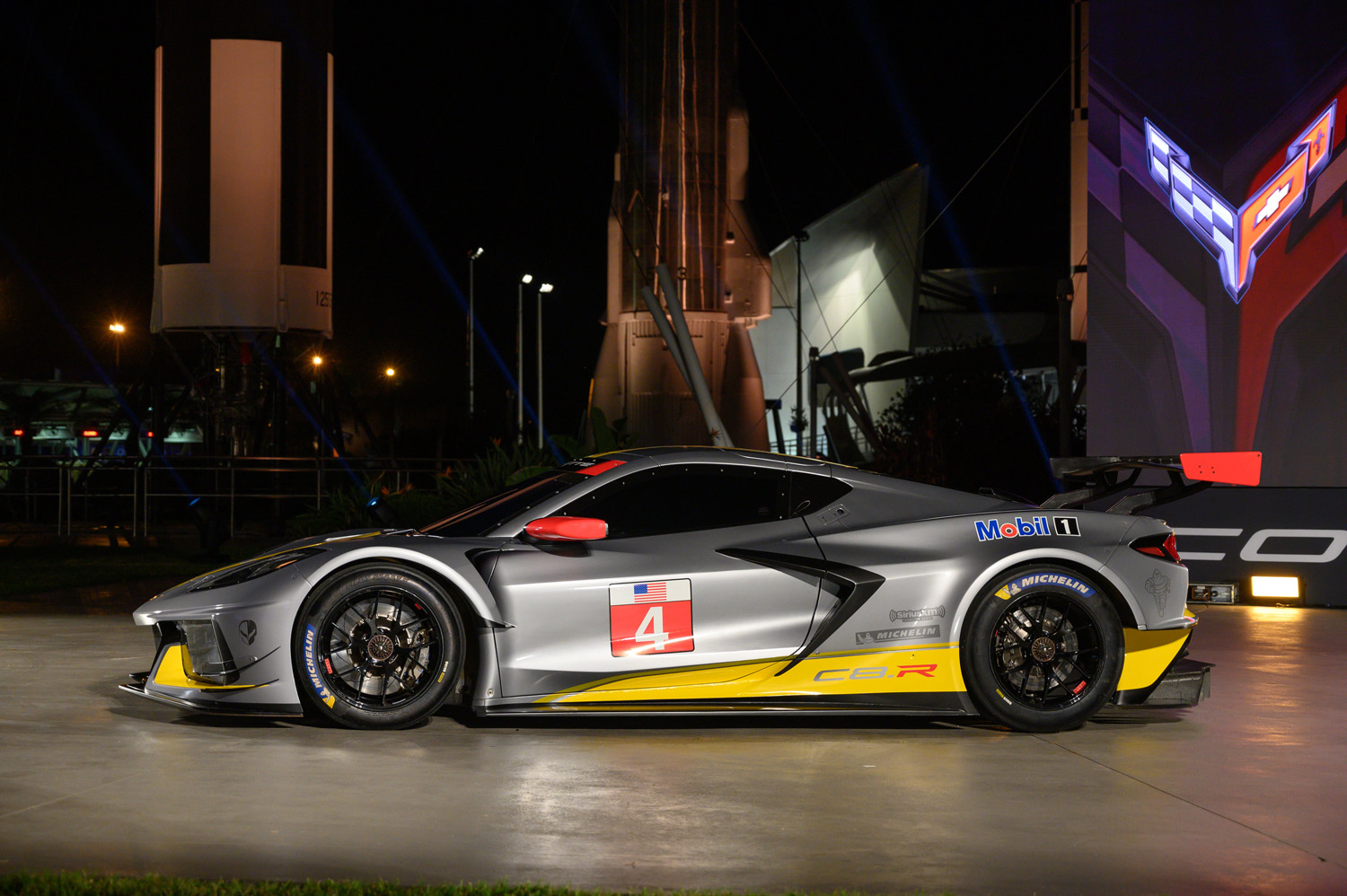What’s under the hood of the Corvette C8.R?
Chevrolet has been coy about the C8.R, but there’s no hiding the fact that the brand’s factory-backed endurance racing team would be moving to the road car’s mid-engine platform. Still, Chevrolet remains tight-lipped about the powertrain details for the upcoming endurance challenger that’s set to make its race debut at the 24 Hours of Daytona next January.
A video of the C8.R shown testing at night at Sebring is fueling speculation about its powerplant, because it sounds like a totally different beast than we’re used to in an endurance-racing Vette. Gearheads have been speculating about what will power the C8.R for more than a year, and this video is on fanning the flames.
There are rumors that a twin-turbocharged DOHC flat-plane-crank V-8 related to Cadillac’s Blackwing engine (found in the CT6-V) would power the production Corvette Z06, and in turn, the C8.R. Cadillac claimed its engine will be exclusive, leading us to believe that when the DOHC engine does make its debut in the Corvette, it will be in a significantly redesigned form.
Leaked 3D models of the supposed Z06’s DOHC, twin-turbo powerplant were posted by GMAuthority.com, showing a different engine than the hot-V design used in the CT6-V, backing up Cadillac’s claim of exclusivity for that specific powerplant.
The Z06 hasn’t been revealed, and won’t be for perhaps a year or more, so we’ll have to wait to find out. Going racing with an engine you can’t purchase in the production version goes counter to Automobile Club de l’Ouest’s (ACO) homologation rules for the LM GTE class, so unless the Z06 makes itself seen really soon, team Corvette would likely need an exemption to run anything other than a pushrod V-8 at Le Mans. The ACO has been known to grant exemptions for engines that are similar to those found in other production models, so the CT6-V could be the back door to getting a DOHC V-8 into the C8.R. That would, however, depend on just how different these engines turn out to be.
We were eager to learn more about the upcoming racer and hear its V-8 in person, and Chevrolet surprised us by driving the C8.R into the reveal of the 2020 Corvette convertible. Though we didn’t learn any engine details for certain, being present for the experience did yield some very good clues. First off, it revved quickly, with fantastic throttle response. We also heard a burbling idle that sounded distinctly like a lumpy camshaft.
On top of that, we didn’t hear any of a turbocharger’s telltale sounds in person, or on the Sebring video, for that matter. There was no blow-off valve purging boost when the engine was quickly revved and then settled back into its idle, and there was no characteristic spooling sound, either. When we heard it in person, it also didn’t seem to have much in the way of mufflers—snail-shaped spinny ones or otherwise.
A video that Chevrolet released to coincide with the C8.R sneak peek revealed just a bit of the engine. It shows a carbon-fiber plenum with a single round inlet that points aft to what we assume to be an air cleaner and intake restrictor. The setup looks quite similar to the intake used on the naturally-aspirated Ferrari 458 GTE. With no throttle body in sight, it’s likely the engine uses individual throttle bodies, just like the C7.R. That would also explain the crisp throttle response. We don’t see how this engine could be turbocharged.
The maximum displacement allowed in the LM GTE class is 5.5 liters for naturally-aspirated engines and 4.0 liters when boosted. With turbochargers eliminated from contention, that still leaves a few options that make sense.
A 5.5-liter V-8 would have some sizable pistons, especially with the race version of the engine likely using a big bore/short stroke combo to get the maximum air flow out of the heads and keep piston speeds low for longevity. However, bigger, heavier pistons exacerbate the inherent flaws of a flat-plane design and could make for some serious vibration issues—not at all what you’d want for an endurance racing design that would have 24 hours to work at shaking every fastener on and around the engine until something comes loose.
The Mustang Shelby GT350 garnered all sorts of hype for its 525-horsepower flat-plane-crank V-8 engine and the fun noises it makes, but it’s something of an anomaly. At 5.2 liters, it’s uncommonly large-displacement for a production flat-plane V-8 engine. Like a large-displacement inline four-cylinder, a flat-plane V-8 isn’t terribly refined and isn’t as balanced as a comparably-sized cross-plane V-8.
If the C8.R’s new engine is a flat-plane-crank DOHC V-8, which seems likely, it may come in at less than 5.5 liters and leave some displacement on the table. That is, unless Chevy figured out a way to reduce reciprocating mass or deal with second-order vibration. However, we can’t rule out that the C8.R could be powered by a 5.5-liter cross-plane V-8 based on existing pushrod architecture, similar to the engines that have been in use in use since the C6.R.
The 5.5-liter small-block V-8 is a proven race package, and with such a huge shift to the mid-engine C8 platform and the learning curve that comes with an all-new design, we’d think that any familiarity that the race team could retain would be an advantage. If the C8.R has a cross-plane crankshaft, it could still have the sound and exhaust scavenging benefits afforded by a flat-plane crankshaft if it uses 180-degree headers.
The mid-engine location of the LT2 in the Stingray allows for a set of beautiful tubular headers that move the collector high above the exhaust ports to more efficiently scavenge exhaust than the block-hugging manifolds found on the C7. Taking the production C8’s exhaust to its next evolution, we can imagine a set of 180-degree headers that swap two primary exhaust tubes from each side. It would give a cross-plane V-8 the same exhaust scavenging benefits and characteristic sound of evenly-spaced exhaust pulses of a flat-plane-crank without its drawbacks.
In the brief shot of the C8.R’s engine bay that was offered in the video, there’s no tangle of tubing above the engine like the “bundle of snakes” exhaust famously used in Ford’s GT40, although there may be room to run the tubes low through the engine bay. As the C8.R won’t have much use for a trunk that can stow a pair of golf bags, there looks to be a lot of room in the C8.R to build an exhaust that achieves equal-length primary tubes and 180-degree firing separation.
We could be wrong, of course. No matter how the Corvette team managed to produce such wonderful noise from the C8.R’s powerplant, we’re still excited to see it do battle with the world’s best when it competes starting in January. We just think it would be extra sweet if it did so with Chevrolet’s legendary pushrod V-8.














